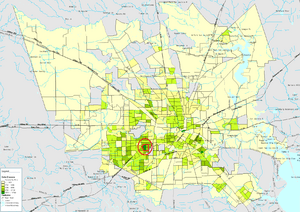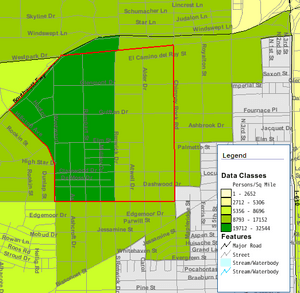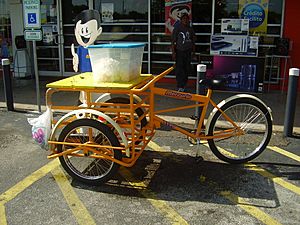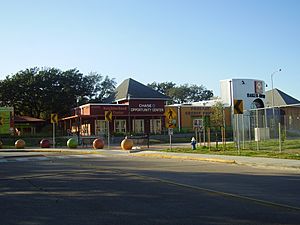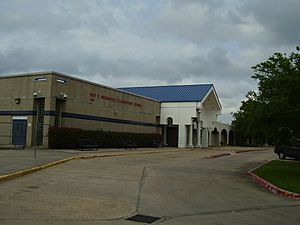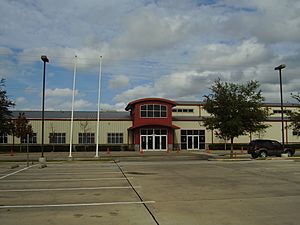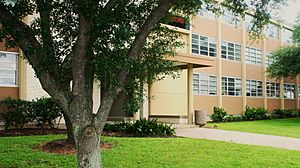Gulfton, Houston facts for kids
Quick facts for kids
Gulfton
|
|
|---|---|
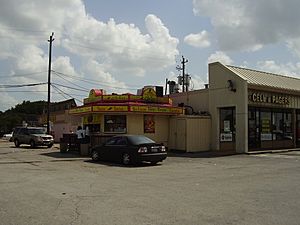
A shopping center in Gulfton
|
|
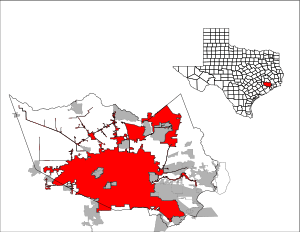 |
|
| Country | United States of America |
| State | Texas |
| Population | |
| • Estimate
(2000)
|
46,287 |
| • Urban density | 14,477/sq mi (5,590/km2) |
| Time zone | UTC-6 (CST) |
| • Summer (DST) | UTC-5 (CDT) |
Gulfton is a community in Southwest Houston, Texas, United States3.2 sq mi (8.3 km2). It is located between the 610 Loop and Beltway 8, west of the City of Bellaire, southeast of Interstate 69/U.S. Highway 59, and north of Bellaire Boulevard.
In the 1960s and 1970s Gulfton experienced rapid development, with new apartment complexes built for young individuals from the Northeast and Midwest United States. They came to work in the oil industry during the 1970s oil boom.
In the 1980s, as the economy declined, existing tenants left, resulting in a significant drop in occupancy rates in the apartment complexes and forcing many complexes into bankruptcy and foreclosure. Owners marketed the empty units to newly arrived immigrants and Gulfton became a predominantly immigrant community.
By 2000 Gulfton was the most densely populated community in Houston, with 71 percent Hispanic residents, including many recent immigrants from Mexico and Central America. Although traditionally a Salvadoran and Mexican neighborhood, many immigrants began coming from different Latin-American countries, particularly from Venezuela, Honduras, Cuba, Guatemala and Colombia. There are also American citizens from other states and territories like Puerto Rico.
Contents
Geography
Gulfton is located in Southwest Houston outside the 610 Loop. Gulfton is about 10 mi (16.1 km) southwest of Downtown Houston and approximately 2 mi (3.2 km) west of Bellaire. Susan Rogers of the Rice Design Alliance describes Gulfton is an example of an "inner ring" area of Greater Houston which is located between downtown and the suburbs. Rogers states that the "outwardly conventional landscapes" of "inner ring" areas are "neither urban nor suburban, but a conglomeration of both, a hybrid condition mixed from one part global city, one part garden suburb, and one part disinvestment."
Gulfton includes about 90 apartment complexes with more than 15,000 units. Lori Rodriguez of the Houston Chronicle said that Gulfton, "with its rows of down-at-the-heels apartments that still bear jaunty names from their swinging-singles days, makes an incongruous gateway for the newest waves of immigrants and their many children." Roberto Suro of The Washington Post described Gulfton as a "tightly packed warren." Some of the apartment complexes are over one block long. In the 1970s one of the apartment complexes contained seventeen swimming pools, seventeen hot tubs, seventeen laundry rooms, and two club houses. Gulfton also contains strip malls and office blocks. The complexes generally contain features catering to single adults and lack features appreciated by families, due to the initial market targeted in the 1970s. As of 2005[update], Gulfton has more than one hundred semi-private swimming pools but many of them have been filled in and are no longer usable. Some apartments in Gulfton have businesses located in ground floor units. Several area tract houses are occupied by beauty salons, small stores, and tire repair shops. Rogers contends that the mixed-use adaptation, "has occurred spontaneously from the bottom up, indicative of the entrepreneurial spirit of residents and their need to adapt existing space for new uses." A 2000s City of Houston report on Study Area 8, which includes Gulfton and surrounding areas, states that Gulfton's "large apartment complexes dominate the area's landscape." John Nova Lomax of the Houston Press described Gulfton as "uglier" than a group of apartment complexes along Broadway Street in eastern Houston.
The size of the city blocks in Gulfton differs significantly from that of Downtown Houston in that sixteen downtown city blocks will fit into one Gulfton block. Few sidewalks exist in Gulfton. In 1999 Houston City Council District F representative Ray Discroll said "[Gulfton residents] don't have sidewalks, let alone sidewalks that are only two and a half feet wide. There are pregnant women walking down the sides of the roads." In 2005 the Houston-Galveston Area Council identified Gulfton as one of the most hazardous communities for pedestrians. Dug Begley of the Chronicle wrote in 2019 that "pedestrians and cyclists, [sic] navigate streets designed for cars that can leave residents facing wide intersections with fast, unimpeded right turns and signal timing that forces younger, elderly and disabled travelers to hustle, as hundreds of cars pass by." That year the organization Together for Safer Roads planned to fund a study on Hillcroft Road, discussing ways of making pedestrians there safer, with $150,000; it plans to work with the municipal government.
One complex, Napoleon Square, was built in 1971 for $22 million; the 1,884 unit complex, owned by real estate figure Harold Farb, included a $400,000 disco and many swimming pools. In 1977 it had a main swimming pool, twelve other swimming pools, and a club called "Bonaparte's Retreat." Within a 1-mile (1.6 km) radius of the main entrance to Napoleon Square, 5,000 apartment units in at least twelve apartment facilities, about forty swimming pools, about or more than twenty-four bars and nightclubs, and about twelve tennis courts. A subsidiary of Western Capital purchased the complex in March 1985. As of 1999, about 1,500 families reside in the complex, and most of them originated from Mexico, Central America, and South America. As of 2003[update] many families at Napoleon Square came from Mexico, Honduras, other Central American countries, and South America. The Napoleon Square and Lantern Village complexes have a combined total of over 1,000 units and, as of 2000[update], several thousand inhabitants.
Demographics
Between 1980 and 2000 the population of Gulfton increased by almost 100% without significant additional residences built. Between the 1990 U.S. Census and the 2000 Census, the counted Hispanic population in Gulfton increased from 18,422 to 33,424, an 81% increase, and the non-Hispanic White population decreased from 6,371 to 4,908, a 23% loss. Occupancy rates at many apartment complexes increased; for instance, Napoleon Square's rate increased from 60% around 1996 to over 95% in 2001. Mike McMahon, the co-founder of the Gulfton Area Neighborhood Organization (GANO), said that increased census worker efforts to ensure a more accurate population count may have also contributed to the increase.
2020s
In 2021 about 12% of households in Gulfton did not have cars, while the Houston average was around 6%.
Economy
Gulfton includes several scattered areas of commercial and light industrial properties. Gulfton gained a large number of immigrants in the mid-1980s and the regional economy could not support the increasing pressure of the new workers. This led to higher unemployment rates and families tended to "double-up" housing, where multiple families shared the same unit to reduce family expenditures. Scott Van Beck, head of the Houston Independent School District's West Region in the Gulfton area, stated in a 2006 keynote address to the Rotary Club of Bellaire, "When I look out my window on Chimney Rock, I don't see big corporations; I see Gulfton; I see mom and pop businesses." The Houston Metropolitan Chamber, previously the Greater Southwest Houston Chamber of Commerce, provides economic assistance in Gulfton. As of 2005[update] many Central American businesses have outlets in Gulfton. ADOC footwear has its only United States store located in Gulfton. Pollo Campero has the Bellaire location in Gulfton. Salvadoran banks have three branches and an importing business in the area. As of 2004[update] the Salvadoran banks include Banagricola (a U.S. division of Banco Agricola), BancoSal (a subsidiary of HSBC El Salvador) and Bancomercio. At that time many businesses in Gulfton, including small grocery stores and restaurants, were owned and operated by Salvadoran refugees from the Salvadoran Civil War. Grupo TACA operates the Houston-area TACA Center on Bellaire Boulevard in the Gulfton area. Additionally, Famsa, a Mexican appliance and furniture chain, operates the #38 Bellaire location in the Southwest Management District, adjacent to Gulfton. Throughout the neighborhood food vendors, called paleteros, travel on bicycles and sell foods and snacks such as spiced cucumbers and popsicles (paletas).
The emergence of the Latino community led to changes in area businesses as they catered to the predominant population. In 2003 Kroger remodeled its Gulfton supermarket to cater to the new demographic. In December 2010 Kroger announced that the 59,000-square-foot (5,500 m2) Kroger in Gulfton would close by the end of January, as it has been an under-performing store. Kroger owned the store location, and the chain was considering selling it to another grocery chain.
Fox Sports Net technical operations were formerly located on Gulfton Drive, before it moved to Fox Network Center - Woodlands in unincorporated Montgomery County around 2008. A 2008 Houston Chronicle article described the former FSN Network Operations Center as "flood-prone." It employed around 300 staff. In 2001 a partnership formed between Ed Farris, of Farris & Associates, and U.S. Builders for the construction of Plaza de Americas, a 30,000-square-foot (2,800 m2) shopping center adjacent to the Kroger in Gulfton. The project was completed for $4 million ($6610787.45 in today's money) and hoped to attract retailers catering to Hispanic clients. Lane Design Group designed the center with a "Hispanic flavor." The developers believed that the Hispanic buying power in the Gulfton area would generate profits.
Culture
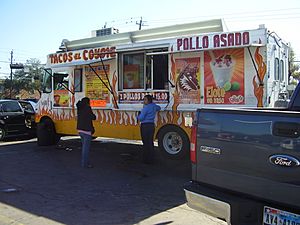
Oriana Garcia, a Gulfton-area community developer of Neighborhood Centers Inc., described Gulfton as, "sort of like the Ellis Island of the current time." Residents represent seventy distinct cultures, speak thirty different languages, and live in an area approximately 16,000 square feet (1,500 m2). Garcia refers to the population as, "probably the most dense area in Houston." Adrian Garcia, the anti-gang office director for the Mayor of Houston in 2002, also referred to Gulfton as, "somewhat of an Ellis Island." Susan Rogers of the Rice Design Alliance said that Gulfton's "affordable housing, shops, language, food, and culture all help to provide a familiar environment that eases the residents' transition to life in America." Rogers also said, "In many ways the residents of Gulfton are more connected globally than locally."
In 1995 GANO activist Francisco Lopez, an El Salvador refugee, said, "Gulfton is what Denver Harbor is to Mexicans. Any recent Latin American immigrant has a relationship to Gulfton." Lopez added that the immigrants mainly remain in the area because of the Fiesta Mart and other businesses that cater to the immigrant population. Lopez explained that many people originally expected Gulfton would provide a transient location for immigrants, who would then leave for other neighborhoods. By 1995 many had stayed in Gulfton and become long term residents even switching apartments but not leaving the area. In 2010 Katharine Shilcutt of the Houston Press said "Gulfton now possesses such a wide range of ethnic cuisines, restaurants and grocery stores, it can almost be seen as a microcosm of Houston."
The popularity of soccer (football) in the neighborhood flourished after the Southwest Houston Soccer Association was established in the 1990s. Prior to its establishment, a few adult teams existed, but no youth league. In 1995, Silvia Ramirez, a soccer coach, said in a newspaper article that a lack of confidence in English language abilities and long work hours prevented many area residents from creating soccer leagues. The same article quotes citizens who believe that playing soccer prevented them from joining gangs. In 2007, Diana De La Rose, principal of Jane Long Middle School, said that soccer was popular among Gulfton-area students. In 2010 the Houston Dynamo soccer team proposed the construction of a stadium near Gulfton. Instead the BBVA Compass Stadium began construction in East Downtown.
Neighborhood Centers Inc. began work in the Gulfton and Sharpstown areas around 30 years before 2011. In 1998 Neighborhood Centers opened El Puente (The Bridge), a privately operated community center on the grounds of the Napoleon Square Apartments, a complex which had a predominantly Spanish-speaking population. El Puente is located in three apartment units that had been converted into office space and play areas. Two of the apartment units are connected to each other. The center's goal is to provide community support to replace the community support that the immigrants had previously received in Latin America. As of 1999, ten different agencies provided services at El Puente and 135 families signed up to receive the services. As of 1999, at the center, the Houston Public Library provided literacy classes, Houston Community College provided English classes, the Houston Independent School District provided preschool services for three- and four-year-olds, the University of Houston Graduate College of Social Work arranged assessments for graduate students studying social work, and the Sisters of Charity's Southwest Clinic provided prenatal and preventive medical services. In 2003 the Chrysalis Dance Company provided dance sessions at El Puente, used to teach English to mothers and children. Maricela Grun, the coordinator of the complex, said in 1999 that the center was needed because children had few activities available. She said that "The children have very little to do. They're just confined to their apartments." In 2007, the group announced that it would build the Gulfton Neighborhood Campus at the intersection of Rookin Street and High Star Drive, once it raises the $20 million ($28226608.89 in today's money) needed.
The Baker-Ripley Neighborhood Center, in the Southwest Management District, was scheduled to open in December 2009. The center consists of a 4 acres (1.6 ha) campus with five buildings. Designed by New Orleans-based Concordia architects and landscaped by Asakura Robinson Company, the site contains a farmers market, health clinic, outdoor film venue, publicly accessible library, school, and some outdoor recreation areas. The center design incorporates architectural influences from Mexican and South American art. Rosa Gomez, an employee of Neighborhood Centers, said that the organization did not want Baker-Ripley to appear "too fancy or official looking" so as not to intimidate recent immigrants. The non-profit organization Project for Public Spaces assisted in the development of Baker-Ripley. The organizers consulted residents of Gulfton and Sharpstown on the design of the center. Susan Baker, the wife of James Baker, a former U.S. Secretary of State, organized a fundraising campaign for the center. The center offers English and computer classes. Neighborhood Centers received a United States Department of Education Promise Neighborhood planning grant, used to fund its Gulfton Promise Project, a program to guide residents from birth until they obtain careers. A 2013 Houston Chronicle article stated that the center had never experienced a break in incident and that the Gulfton community "embraced" it.
Texas Children's Pediatric Associates Gulfton is a child health care center affiliated with Texas Children's Hospital. As the third such pediatric primary health care center opened by Texas Children's, the Gulfton campus exists as part of Project Medical Home to assist families with financial hardships avoid using emergency departments for primary care visits.
In 2004, many promotoras (promoters) operated in Gulfton. These individuals are recruited from "hard-to-reach" communities and study health care from doctors and non-profit organizations and then return to their communities to educate people in health care practices. U.S. public health care programs adopted promotoras from the Latin American model, although its use in Gulfton varies some from the Latin American system. For example, promotoras in the U.S. cannot legally dispense medication.
Prior to the change in demographics, at one apartment complex, Napoleon Square, residents socialized at the swimming pools on afternoons. The area nightclubs were active during evenings. During that era the members of the ethnic groups in the Napoleon Square apartment complex mainly kept to themselves. Harry Hurt III of the Texas Monthly said "while being one of the most integrated neighborhoods in Houston with its rainbow of human kinds and colors, Napoleon Square seemed to be one of the most factionalized, hardly a melting pot."
Religion
The Roman Catholic Archdiocese of Galveston-Houston operates Holy Ghost Church on a 10-acre (4.0 ha) property, in the Gulfton area, one city block from Bellaire. The church building is in the shape of a "T". In 2006 it had about 4,000 regular parishioners. It give church services in both English and Spanish, with three masses per language each week. In 2006 a man who was bilingual in English and Spanish was the pastor. A group of volunteers created stained glass windows that were put in the church by 2008; the project began circa 1983.
Additionally there are various "storefront churches" for non-Catholic varieties of Christianity.
Education
Primary and secondary schools
Gulfton is zoned for public schools in the Houston Independent School District (HISD) and divided between Trustee District V and Trustee District VII.
As of 2010[update] the Student Assessment department of HISD and the Technology Department Technical Support Services and Training offices (Teledyne Training Facility) are located in a building in the Gulfton area. Previously the district's West Region offices, Charter and Safe Schools Initiatives office, Health and Medical Services office, and Virtual School Department were located in the facility. Prior to HISD's 2005 reorganization, the Southwest District was headquartered where the West Region offices and Alternative Education offices now reside. Around 2004 the West Central District offices occupied the Chimney Rock facility.
Elementary and middle schools
The attendance boundaries of Benavidez Elementary School, Braeburn Elementary School, Cunningham Elementary School, and Rodriguez Elementary School cover sections of Gulfton. The Gulfton area is zoned to Jane Long Middle School with Pin Oak Middle School, located in the City of Bellaire, as an option. Pin Oak was named a National Blue Ribbon School in 2008.
Gabriela Mistral Early Childhood Center in Gulfton is the early childhood center nearest Gulfton. Poor students, homeless students, students not proficient in English, and children of active-duty members of the U.S. military or whose parents have been killed, injured, or missing in action while on active duty may attend Mistral. Las Américas Middle School and Kaleidoscope Middle School, two optional middle schools, are located in the Long Middle School campus.
Several state charter schools are located in Gulfton. SER-Niños Charter School is a pre-kindergarten through 8th grade state charter school in Gulfton. SER-Niños as of 2009[update] receives state funds per student and relies on philanthropy for other expenses. Prospective students receive admittance based on a lottery. The students are mostly of Mexican and Salvadoran descent. Amigos Por Vida Friends For Life Charter School, opened in 1999, is a state charter school for pre-kindergarten 3 through grade 8. The Academy of Accelerated Learning, Inc. operates a charter school in Gulfton. YES Prep Gulfton, home of the Force (originally YES Prep Lee), a state charter middle and high school that was originally located on the Lee High School campus, expanded to the six through twelve grades with thirty classrooms. As of 2007[update] many students at YES Prep Lee were from the Gulfton area. YES Prep Gulfton is now located in the Southwest Management District. The Baker-Ripley Charter School is located on the grounds of the Baker-Ripley Neighborhood Center in the Southwest Management District. KIPP Houston operates KIPP: Connections in the Southwest Management District. The Juvenile Justice Charter School serves residents of the Burnett-Bayland Reception Center and the Burnett-Bayland Home.
There are several private schools in the Gulfton area. Robindell Private School serves preschool through Grade 3. In addition to acting as a private elementary school, it also houses a 24-hour daycare program. The Holy Ghost School, a PreK-8 Roman Catholic school operated by the Roman Catholic Archdiocese of Galveston-Houston, is in the Gulfton Super Neighborhood.
Most children live within 2 mi (3.2 km) (as measured by travel along the closest public roads) of their assigned elementary schools, so they are usually not eligible for free school bus transportation. This means that many children have to walk or ride bicycles to school.
History of elementary and middle schools
In 1953, Cunningham Elementary School, the first elementary school to serve Gulfton, was built with a capacity for 300 students. Braeburn Elementary School opened in 1956. Long Middle School, which as of 2008[update] serves Gulfton, opened in 1957.
In 1979, Cunningham Elementary School had 436 students, well over its original capacity of 300. 75.5% of them were White, 14% qualified for free lunch, and 15% qualified for reduced cost lunch. Due to the increasing population and the sudden conversion of adults-only complexes to family oriented, Cunningham Elementary School became overcrowded by 1986 with its enrollment increasing from around 500 in 1985 to more than 900 the next year. By 1988, Gordon Elementary School, a campus in Bellaire, Texas, re-opened to serve as a reliever school to Cunningham and to a non-Gulfton school. By September 3 of that year, 1,268 students were enrolled at Cunningham; 72% were classified as Hispanic and 99% were on free or reduced-cost lunch programs. Many of the children arrived from Central American countries experiencing civil strife, and therefore many had received an inadequate education prior to coming to the United States. In 1989, Cunningham's overcrowding was described as being "unanticipated." In 1988 the U.S. federal government passed the Fair Housing Act, which, under most circumstances, prohibits any policy that excludes families with children from living in an apartment complex. Abbe Boring, the principal of Cunningham in 1992, said that the student population increased when formerly singles-only apartments were required to allow families to rent complexes. In September 1991 Braeburn and Cunningham were two of 32 HISD schools that had capped enrollments; in other words, the schools were filled to capacity and excess students had to attend other schools. By 1992, Cunningham had around 1,200 students and 51 temporary classroom units. Immediately prior to the opening of Benavidez, Cunningham had 1,400 students.
Benavidez Elementary School, which opened on Tuesday, January 21, 1992, relieved Cunningham of around 675 students and 29 teachers. Benavidez, along with two other schools, was a part of a $370 million Houston ISD school construction project, which originated from a school bond approved in March 1989. Rose Garza, the principal of Benavidez, said that the committee determining the name of the school named it after Roy P. Benavidez, a soldier in the Vietnam War who was given the Medal of Honor, because the school wanted to name the school after a Hispanic who could serve as a positive role model to the mostly Hispanic student body that occupied the school when it opened. HISD officials said that the district had little difficulty opening the three schools in the middle of the year, since the same teachers had been teaching the same students while they occupied the previously overcrowded schools in the preceding fall. On its opening day Benavidez referred 400 students to other schools due to overcrowding. After Benavidez opened, Benavidez and Cunningham each had about 700 students. In 1994, Benavidez had 1,065 pupils and it had to send 200 children to different schools. As of that year, 88% of Benavidez's children were Hispanic. By 1996, both Cunningham and Benavidez became overcrowded. Gordon also became a reliever school for Benavidez and another non-Gulfton school. SER-Niños opened in 1996. In 2000 Benavidez had 1,300 students and Cunningham had 1,190 students. At the schools, the average classroom size was 30 students, exceeding the state's recommendation of 22 students per classroom.
The Las Américas Education Center, which included a preschool named Las Américas Early Childhood Development Center and two middle schools, Las Américas Middle School and Kaleidoscope Middle School, started in 1995 as a reliever campus for Cunningham and Benavidez. The reliever school was established with funds from the "Weed and Seed" program established by City of Houston officials. In 2000, the center moved into the Las Américas Apartments in Gulfton.
Rodriguez Elementary, built on almost 10 acres (4.0 ha) with Rebuild 2002 funds, opened during the first week 2002 to relieve Benavidez, Braeburn, and Cunningham. As a result, Rodriguez's attendance zone took territory from Benavidez and Cunningham's zones, while Cunningham's zone took territory from Braeburn's zone. Pin Oak Middle School in Bellaire opened in 2002 to relieve several overcrowded schools in southwestern Houston.
HISD paid around $200,000 USD to lease the Las Américas units. In October 2006, Michael Marquez, president of the Hispanic Housing and Education Corporation, which operated Las Américas, announced to HISD in a letter that the organization would terminate the lease agreement because of issues related to maintenance and management. The district decided to vacate the property instead of appealing the decision. In summer 2007, the former Las Américas Education Center closed. The early childhood center merged with Mistral and the middle schools moved to the Long Middle School campus.
Gordon Elementary School, located in the City of Bellaire, served as a reliever campus for Benavidez, Cunningham, and two non-Gulfton campuses, until it was converted into a Mandarin Chinese immersion school in 2012.
High schools
Gulfton residents are zoned to Margaret Long Wisdom High School (formerly Robert E. Lee High School), which opened in 1962 to relieve Lamar High School, with Lamar and Westside high schools as options. Most Gulfton high school-aged residents attend Wisdom High School. When it opened, Wisdom High School had mainly affluent white students; its demographics shifted to a mostly Hispanic and immigrant student body. In September 1991 Wisdom was one of 32 HISD schools that had capped enrollments, and excess students had to attend other schools. When Westside opened in 2000, residents of the Wisdom attendance boundary gained the option to attend Westside instead of Wisdom, with no free transportation provided. By 2004 three out of every four Wisdom students were born to non-English-speaking households.
Some areas of the Gulfton Super Neighborhood, defined by the City of Houston, are zoned to Bellaire High School. HISD also operates Liberty High School, a charter high school for recent immigrants. In January 2005, Houston ISD opened Newcomer Charter School on the Lee High School campus. School officials placed fliers in Gulfton-area apartment complexes, churches, flea markets, and washaterias. The school relocated to a shopping center along U.S. Highway 59 (Southwest Freeway) and adopted its current name in June 2007. In 2014 HISD opened Middle College High School-Gulfton at HCC's Gulfton facility; it is a non-traditional high school program for 150 students. As of 2022 Liberty is now located in Gulfton at the HCC facility.
Students in Gulfton public schools
By the 1997–1998 school year, 75% of Gulfton students qualified for free or reduced-price lunches. Almost 95% of Gulfton students were classified as economically disadvantaged, almost double the Texas rate. More than 70% of Gulfton students exhibited a lack of English language proficiency, while 27.6% of Houston ISD students and 13.4% of Texas residents exhibited this level of deficiency. Susana Herrera, the program coordinator for Houston's Truancy Reduction Demonstration Project, said that truancy was a major issue in Gulfton education and language barriers, a lack of supervision by parents and guardians, "high mobility," lack of familiarity with United States laws, and familial norms act as "barriers to attending school." A publication by the Office of Juvenile Justice and Delinquency Prevention stated that parental characteristics complicated their support of education, including low socioeconomic status, "language and cultural barriers," and "limited opportunities for acculturation." The City of Houston started the Gulfton Truancy Reduction Demonstration Project, which is operated by the Anti-Gang Office under the Mayor of Houston and includes support from Houston ISD, the Houston Police Department, and the municipal courts. Scott Van Beck, the head of HISD's West Region, in a keynote address to the Rotary Club of Bellaire that urban education needs "social capital" or frequent adult contact with children.
Community colleges
Gulfton is within the jurisdiction of the Houston Community College System (HCCS). The community college district operates the HCCS Gulfton Center, inside a 35,100-square-foot (3,260 m2) campus building owned by HCCS. The building opened in 1990 after Mutual Benefit Life Insurance Co. sold the building to HCCS for $700,000 ($1567957.21 when adjusted for inflation). The Gulfton campus is a part of the district's Southwest College.
Libraries
Houston Public Library (HPL) operates the HPL Express Southwest at the Southwest Multi-Service Center in the Southwest Management District (formerly Greater Sharpstown) and adjacent to Gulfton; the center was built in Sharpstown Industrial Park Section 6. HPL Express facilities are library facilities located in existing buildings. Prior to the opening of HPL Express Southwest on January 24, 2008, no libraries existed near Gulfton.
See also
 In Spanish: Gulfton (Houston) para niños
In Spanish: Gulfton (Houston) para niños
- Southwest Houston
- History of the Central Americans in Houston
- Districts and communities of Houston
- Geographic areas of Houston
- Forum Park, Houston
- Link Valley, Houston
- Thai Xuan Village




